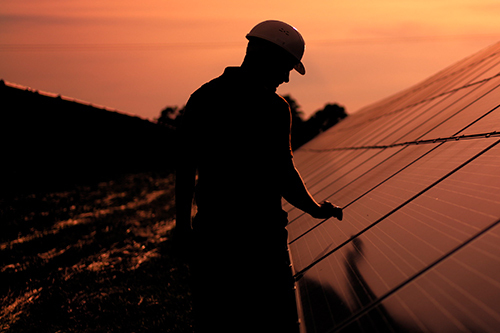
Solar panel maintenance
Solar panel maintenance
Invest in maintenance and save money
Invest in maintenance and save money
PV solar energy offers both environmental and economic benefits, where all members of society win.
The search for clean energy has driven the use of solar panels in many parts of the world. In recent years, the roofs of residential communities, offices, and buildings in general have become generators of energy.
In order to make the most of this energy and ensure its efficiency, it's essential to pay attention to the cleaning and maintenance of solar panels. Although there are different types of solar panels, they all require the removal of dirt, dust, and accumulated debris to improve their ability to absorb sunlight, which maximizes energy production. Here's how to clean solar panels to extend their useful life.
The importance of proper maintenance of solar panels
The importance of proper maintenance of solar panels
Constant developments in solar panel technology have made photovoltaic systems ever more resistant, efficient, and durable. However, that doesn't mean that we shouldn't take care of the equipment. The proper maintenance of solar panels can increase energy production by around 15%.
Regular inspections and proper cleaning ensure optimal operation and therefore higher energy production, which results in long-term economic benefits.
Factors that could affect the useful life of solar panels:
Six steps for proper maintenance of your solar panels
Six steps for proper maintenance of your solar panels
The maintenance of solar panels and regular cleaning to remove the accumulated dirt or debris are the best option to extend their useful life. To make sure you have no doubts about what tools to use and in what order you should do it, let's see how to clean solar panels step by step.
- Schedule regular cleaning
To keep solar panels in good condition, you must clean them at least twice a year: one at the end of fall and another at the start of winter. If they're installed in an area with a high dust, pollen, or dirt concentration, it's recommended to clean them more often, for example every three months. - Choose the right time
The maintenance and cleaning of solar panels must be carried out during the early hours of the morning, when the panels are fresher. Cleaning them when they are still warm or exposed to direct sunlight may be counterproductive, as the combination of heat and cold water can generate thermal stresses and damage the equipment. Avoid when windy, rainy, or snowy. - Gently clean
If you haven't detected any problems, you can start with the cleaning. Make sure you remove any kind of dirt, dust, or debris that may affect the performance of the solar panels. - Carry out a visual inspection
Before starting, carry out a visual inspection of the solar panels to identify possible damages such as cracks, breaks, or loose connections. If you detect any problems, contact a professional to carry out the necessary checks and repairs. - Dry the panels
You can let the solar panels air-dry, or you can use soft cloths. The most important thing is that no water residue remains that may affect the efficiency of the panels. - Monitoring
For proper maintenance, record the date you clean the solar panels, and schedule the next one. This will allow you to properly monitor and maintain the installation in optimal conditions.

Repsol brings solar energy to your home
Would you like to enjoy sustainable energy in your home? Whether you want to install solar panels on your home or want to be part of a solar community, at Repsol we have solutions tailored to your needs.
- Repsol Solmatch:
Solmatch solar communities promote the local and sustainable production of electricity in urban areas. From the installation of solar panels in a specific area, energy is produced so that other homes can connect and benefit from clean and renewable electricity. In this way, you can enjoy solar energy in an urban area, without installations or prior investment.
- Be part of Repsol's solar communities:
Solar communities can be formed in virtually any building: homes, residential communities, businesses, and community buildings. PV panels can be installed on roofs that transform solar radiation into electricity, which is then distributed to nearby homes or businesses.
Solar energy
Solar energy
Learn about the benefits of solar energy.

What types of solar panels are there?
Discover how to benefit from them.

